Early Fall- Best Time to Plant Lawns
Early Fall- Best Time to Plant Lawns
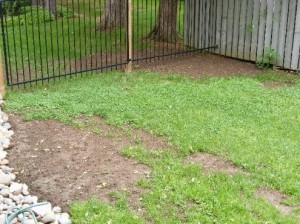 Perhaps you just moved into a new home, or have decided to turn part of your garden plot into lawn, or maybe you had a bad infestation of lawn grubs this summer that destroyed a portion of your lawn. In any case you need to plant a new lawn and might be wondering whether you should plant now, or if you need to wait until spring. And the answer is… PLANT NOW.
Perhaps you just moved into a new home, or have decided to turn part of your garden plot into lawn, or maybe you had a bad infestation of lawn grubs this summer that destroyed a portion of your lawn. In any case you need to plant a new lawn and might be wondering whether you should plant now, or if you need to wait until spring. And the answer is… PLANT NOW.
Without question late summer and early fall is the very best time to plant lawns. The warm soil temperatures encourage quick germination, while the cooler air temperatures reduce the need to water as often. And a big bonus with fall planting is that very few weeds germinate in the fall compared to spring. And that is a big bonus indeed! In east Idaho the best time to plant is mid August to mid September. If cold weather comes early lawns planted after the end of September may not germinate until spring, so later plantings come with a little more risk.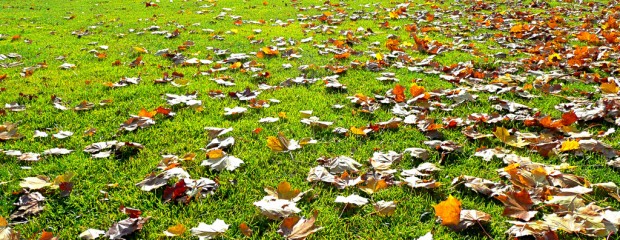
Soil Preparation
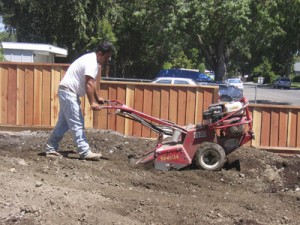 Your first task is to get your soil ready for planting. Most soils in east Idaho will grow a good lawn if fed regularly. If your soil is especially poor, now is the time to add organic matter. Spread up to two inches of Soil Enhancer, Soil Pep, or compost over the entire area. Do not use barnyard manure that may be contaminated with noxious weeds. Use a roto-tiller, preferably a rear tine tiller, to go over the area to be seeded, tilling at least 3-4 inches in depth. Rake out rocks and other debris, leveling as much as possible. When it is sufficiently level apply Town & Country Seed & Sod Starter fertilizer following label directions. This high phosphate fertilizer encourages rapid root development and will go a long way toward helping your lawn get off to a great start.
Your first task is to get your soil ready for planting. Most soils in east Idaho will grow a good lawn if fed regularly. If your soil is especially poor, now is the time to add organic matter. Spread up to two inches of Soil Enhancer, Soil Pep, or compost over the entire area. Do not use barnyard manure that may be contaminated with noxious weeds. Use a roto-tiller, preferably a rear tine tiller, to go over the area to be seeded, tilling at least 3-4 inches in depth. Rake out rocks and other debris, leveling as much as possible. When it is sufficiently level apply Town & Country Seed & Sod Starter fertilizer following label directions. This high phosphate fertilizer encourages rapid root development and will go a long way toward helping your lawn get off to a great start.
Sowing the Seed
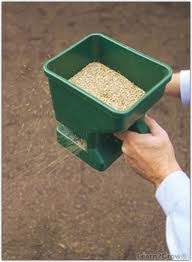 Now you need to decide which seed to purchase and plant. The choice of seed variety is important. You will be living with this lawn for many years and a few extra dollars spent at planting time can save many dollars (and hours) spent on fertilizers and disease and weed control later on. The old adage “you get what you pay for” definitely applies here. Premium varieties of Kentucky Bluegrass are best adopted to our east Idaho soils and climate. You might also consider a blend of bluegrass and endophyte enhanced ryegrass. The endophytes make the grass more resistant to grub damage.
Now you need to decide which seed to purchase and plant. The choice of seed variety is important. You will be living with this lawn for many years and a few extra dollars spent at planting time can save many dollars (and hours) spent on fertilizers and disease and weed control later on. The old adage “you get what you pay for” definitely applies here. Premium varieties of Kentucky Bluegrass are best adopted to our east Idaho soils and climate. You might also consider a blend of bluegrass and endophyte enhanced ryegrass. The endophytes make the grass more resistant to grub damage.
Seed should be applied on a calm day using either a drop or broadcast spreader. If neither of these is available, seed may be hand sown using a sweeping motion to get an even distribution. This technique requires a little practice but can be satisfactory for small areas. Bluegrass may take as long as 14 to 30 days to germinate whereas perennial rye may be 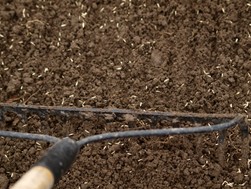 up in as little as 7 to 10 days. Warm soils will speed up germination. Sow grass seed at the rate of 3 lbs. per 1,000 sq. ft. After seeding is completed, rake lightly to mix in the seed. About half the seed should still be visible on the surface. You can also apply a light mulch of peat moss, Soil Enhancer, Soil Pep bark mulch, or clean straw. If clean straw is not available do not apply anything. Dirty straw containing weed seeds is more trouble than it’s worth. Soil Pep and peat moss are free of weed seeds. If you have an automatic sprinkling system that can be set to water several times each day you probably won’t need to use any surface mulch.
up in as little as 7 to 10 days. Warm soils will speed up germination. Sow grass seed at the rate of 3 lbs. per 1,000 sq. ft. After seeding is completed, rake lightly to mix in the seed. About half the seed should still be visible on the surface. You can also apply a light mulch of peat moss, Soil Enhancer, Soil Pep bark mulch, or clean straw. If clean straw is not available do not apply anything. Dirty straw containing weed seeds is more trouble than it’s worth. Soil Pep and peat moss are free of weed seeds. If you have an automatic sprinkling system that can be set to water several times each day you probably won’t need to use any surface mulch.
Watering the Lawn
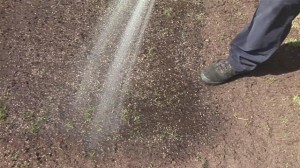 Water thoroughly immediately after seeding and continue to keep moist by watering one to three times a day until the seed is germinated. Hot or windy days will require more frequent watering than cool cloudy days. Watering can be done by hand for small areas, or with hose sprinklers or sprinkler systems. Remember that it will take up to 30 days for all the bluegrass to germinate. Do not allow the surface to dry out during this period. Improper watering is the primary cause of failure when starting new lawns. Also, avoid watering too long in one setting, or puddling and run off may occur.
Water thoroughly immediately after seeding and continue to keep moist by watering one to three times a day until the seed is germinated. Hot or windy days will require more frequent watering than cool cloudy days. Watering can be done by hand for small areas, or with hose sprinklers or sprinkler systems. Remember that it will take up to 30 days for all the bluegrass to germinate. Do not allow the surface to dry out during this period. Improper watering is the primary cause of failure when starting new lawns. Also, avoid watering too long in one setting, or puddling and run off may occur.
Caring for your Lawn
Once the lawn seed has germinated, decrease the frequency and increase the amount of each watering so that you are eventually providing ½” to 1″ of water every three days during hot weather. Sandy soils need more frequent watering. Clay types should be watered less often. If you are planting in the fall your frequency of watering will be reduced if the weather is cooler. Just make sure the surface never dries out during the first month after planting. Apply Town & Country Premium Lawn Food 30 days after most of the seed has germinated. This is a very important step to keep the lawn from “stalling”. Do not mow until the grass has reached a height of 3 inches. A mowing height of 1 ½ to 3 inches is recommended thereafter. Do not apply any weed killers until after the third mowing. In the case of fall planting that means waiting until spring to spray for weeds. Kids can play on the lawn once it has grown enough to be mowed. Following these guidelines should result in a beautiful lawn that you will enjoy for years to come.



